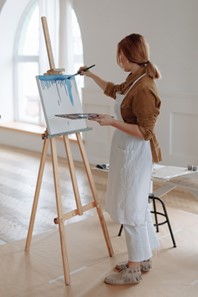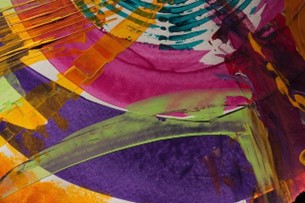
 Art therapy uses both the creative art process and psychological theory. Grounded in the belief that the creative process is inherently healing, the practice of art therapy also includes psychodynamic, humanistic, learning and developmental, educational, cognitive behavioral and other therapeutic approaches (Haaga).
Art therapy uses both the creative art process and psychological theory. Grounded in the belief that the creative process is inherently healing, the practice of art therapy also includes psychodynamic, humanistic, learning and developmental, educational, cognitive behavioral and other therapeutic approaches (Haaga).
Through the process of creating art people can express themselves in a different way. It is an outlet to help people learn more about their thoughts and feelings, improve self-esteem and behaviors, handle inner conflicts, cope with trauma, and heal. The type of art therapy may vary depending on a person’s needs or preferences. The type of art could be drawing, painting, carving, collaging, modeling clay, pottery, sculpting, photography, etc.
Other creative art therapies include dance, drama, music, and writing.
Therapeutic art is often used to learn something, or experiment with creating a visually pleasing piece of art that may be displayed. Art therapy is an indirect and creative method for communicating, expressing, and share a person’s thoughts or feelings. It may also be used to develop new skills for coping or helping improve social skills. No talent is needed to do art therapy.
Although they have different goals, they may have similar benefits of reducing stress or improving a person’s wellbeing through self-expression. Another distinction worth mentioning is how art therapy differs from an art class, which focuses on technique, talent and aesthetics (Hearts of Hope Therapy).
Art Therapy is Also Not the Same as Doing Art in Therapy
Doing art in therapy is also not the same as doing art with an art therapist. Art therapists have special training in handling mental health concerns with the use of art therapy.
Another thing that makes art therapy uniquely different is the therapeutic relationship between the therapist and the client. Art therapists are trained to recognize symbolism in art and start discussions around the art that was created. Sometimes a client may have strong emotions that surface during or after the creative process. An art therapist has the training to help a person process those emotions in an effective, safe way. A traditional therapist does not have the proper training for this.
Art therapy is a mind-body therapy that recognizes the important ways in which psychological, emotional and social factors can influence physical health (Haaga). It is often used as a complementary therapy to other chronic pain treatments.
 According to the American Art Therapy Association, “Art therapy is used to improve cognitive and sensorimotor functions, foster self-esteem and self-awareness, cultivate emotional resilience, promote insight, enhance social skills, reduce and resolve conflicts and distress, and advance societal and ecological change (American Art Therapy Association).”
According to the American Art Therapy Association, “Art therapy is used to improve cognitive and sensorimotor functions, foster self-esteem and self-awareness, cultivate emotional resilience, promote insight, enhance social skills, reduce and resolve conflicts and distress, and advance societal and ecological change (American Art Therapy Association).”
Here are all the Benefits of Art Therapy:
- Self-Expression
Art is a form of communication and therefore can help a person express physical and emotional health problems that are too complex to share verbally.
- Developing Awareness and Understanding
Art therapy can help a person share their story, gain new information, and self-reflect. For instance, you may focus on making a piece of art that represents what your pain looks like on that particular day, and then discuss how the pain is connected to the different lines, shapes, and colors you create (Solan, 2018).
- Distracting from Pain
Art can also be a great distraction from pain since pain is typically worse when more attention is given to it. Art therapy can help a person to relax which changes their mood and lowers their perception of pain. Many people were interviewed on the subject matter and reported less pain during the process of art therapy. It also has the ability to reduce stress, anxiety, and depression. Stress can often create physical pain as well as psychological.
 Improving Doctor’s Understanding
Improving Doctor’s Understanding
Being able to share through art can help a practitioner to better understand a person’s pain to improve their quality of treatment. Researchers have actually seen the benefits of artwork in helping to understand a person’s chronic pain experience.
A number of themes have shown up through evaluating art and comments that accompany them. Such themes include hopefulness, pain as a journey, gaining pain and losing self, redefinition of self, fighting against the “pain identity,” facing new limitations and boundaries and working toward adjustment and acceptance (Haaga).
- Improving Relationships & Increasing Socialization
Art work can also help improve relationships with doctors, friends, or family. It helps people to gain a better understanding of a person’s struggles with their invisible illness. Which can help the individual to feel less lonely or inadequate.
- Providing Personal Fulfillment - Improving Self-Esteem
Living with a chronic illness or chronic pain can make a person feel like they lack control over their bodies and their situation in general. Art can help a person feel empowered since they have control over what they create, what they use to create it, and what steps they take. They also have opportunities to problem solve and make decisions.
Art therapy may be used to help a person identify their unique strengths. It can also provide a sense of fulfillment through creating a finished piece of artwork you are not only proud of but also has meaning behind it.
However, it may not be a good fit for someone who doesn’t believe they are creative or artistic because they may not give in to the process. Additionally, it hasn’t been effective for all mental health conditions.
 Art therapy can be especially beneficial to children who struggle to express their emotions through words. Art gives them a creative outlet to share their emotions. It also helps a therapist to more effectively understand their thoughts, and help them cope with difficult emotions.
Art therapy can be especially beneficial to children who struggle to express their emotions through words. Art gives them a creative outlet to share their emotions. It also helps a therapist to more effectively understand their thoughts, and help them cope with difficult emotions.
Art Therapy may help with health issues including:
- Anxiety
- Behavioral Problems
- Cancer
- Depression
- Eating disorders
- Emotional difficulties
- Family or relationship problems
- Medical conditions
- Mental Illness in general
- Neurological problems
- Learning disabilities
- Psychological symptoms associated with other medical issues
- Post-traumatic stress disorder (PTSD)
- Psychosocial issues
- Stress
- Trauma
An art therapy session is facilitated by a professional art therapist who leads a client through art exercises that encourage emotional, creative, and spiritual growth (Worden, 2020).
Art therapy sessions may be anywhere from 30 to 60 minutes. Sessions are often individual, but a therapist may do group sessions for those who would benefit from sharing their experiences. A therapist will usually provide a variety of art materials.
Art therapy is not the same as coloring mandalas in adult coloring books. With art therapy there is a goal to achieve.
 What Does an Art Therapy Session Look Like?
What Does an Art Therapy Session Look Like?
A session will typically start with figuring out what problem needs be addressed. Then an art therapist may help the client choose what art materials are used based on their health condition, what they enjoy, or what health concern they are working to improve.
An art therapist is trained in many different mediums with an understanding of the benefits of each, an understanding of what exercises work best for uncovering specific emotions or thoughts, interpreting the art in a safe space, and managing any trauma that may come to the surface. There is research to support certain art concepts (drawing a road, bridge, mandala, or another subject matter) help with providing insight for specific issues.
The therapist facilitates the art-making process, but the client gets to freely create the art. During the process, the therapist may ask some questions to help the client effectively express themselves. After the art is created, there is a discussion around what was created and how it made the client feel. Through exploring their art, people can look for themes and conflicts that may be affecting their thoughts, emotions, and behaviors (Cherry, 2021).
Evolving ideas about psychology, recognition of the unconscious, and the growing acknowledgement of art as an expression of a person's inner mind gave rise to important notions that led directly to art therapy as an innovative and original mental health discipline (Junge, 2016).
It was found that drawing and painting was just the creative expression needed for tuberculosis patients to handle their complex emotions while dealing with the confines of sanatoriums. The term “art therapy” was officially coined in 1942 by British artist Adrian Hill who suffered from tuberculosis and saw the benefits of drawing and painting. Edward Adamson helped the spread of art therapy to mental hospitals which led to the creation of the British Association of Art Therapists in 1964.
Art Therapy is Founded in the United States
Art therapy became popular in the United States around the same time with the influence of Edith Kramer and Margaret Naumburg. Edith is an artist who became an art therapist while working with young boys with mental health issues. She wrote several books on her experiences utilizing it. She is known for the concept of “art therapist third hand intervention” which encourages therapists to be flexible when helping clients. Margaret is an educator who is referred to as “mother of art therapy” for her extensive work making art therapy a professional discipline. She published many clinical cases and also developed the concept of “dynamically oriented art therapy.”
In 1969 The American Art Therapy Association was founded. By the 20th century, art therapy was a recognized field requiring certification and training in both art and therapy (Tiret, 2017). Organizations were created around the world modeled after the European and United States associations. Art therapy today is now considered a relevant psychotherapy practice and a well-respected profession worldwide.
They must meet standards set by the American Art Therapy Association. They are also required to complete at least 700 hours of supervised art therapy practice as an intern. Some therapists may also choose to specialize in working with certain age groups, settings, or specific health issues.
 If a person has past trauma that is brought to the surface and not handled appropriately it can cause them to be re-traumatized. A non-art therapist may misinterpret art and unintentionally offend a client, misguide a person, or re-traumatize.
If a person has past trauma that is brought to the surface and not handled appropriately it can cause them to be re-traumatized. A non-art therapist may misinterpret art and unintentionally offend a client, misguide a person, or re-traumatize.
Where Do Art Therapists Work?
Art therapists can be found in many different settings including art studios, private practices, wellness centers, hospitals and clinics, treatment facilities, halfway houses, shelters, schools, colleges, correctional facilities, elder care facilities, and community centers.
Some art therapists work as part of a health care team that includes physicians, psychologists, nurses, mental health counselors, marriage and family therapists, rehabilitation counselors, social works and teachers (Explore Health Careers).
Directories for Finding an Art Therapist:
American Art Therapy Association
Art Therapy Credential Board, Inc.
Tiret, Holly. (2017, May 25). Michigan State University/The benefits art therapy can have on mental and physical health. Retrieved by: https://www.canr.msu.edu/news/the_benefits_art_therapy_can_have_on_mental_and_physical_health
American Art Therapy Association/About Art Therapy. Retrieved from: https://arttherapy.org/about-art-therapy/
Solan, Matthew. (2018, July 12). Harvard Health Publishing/Art therapy: Another way to help manage pain. Retrieved from: https://www.health.harvard.edu/blog/art-therapy-another-way-to-help-manage-pain-2018071214243
Worden, Madison. (2020, June 17). Art from the Streets/The Difference Between Art Therapy and Therapeutic Art-Making. Retrieved from:
https://artfromthestreets.org/blogs/news/art-therapy-near-me
Hearts of Hope Therapy/Art Therapy vs. Art in Therapy: What You Need to Know
Retrieved from: https://www.heartsforhopetherapy.com/blog/art-therapy-vs-art-in-therapy
Explore Health Careers/Art Therapist. Retrieved from:
ADELPHI/The History of Art Therapy. Retrieved from:
https://adelphipsych.sg/the-history-of-art-therapy/
Junge, Maxine Borowsky. (2016). APA PSYCNET/History of Art Therapy. Retrieved from:
https://psycnet.apa.org/record/2016-25095-001
Grad Schools/History of Art Therapy. Retrieved from:
https://www.gradschools.com/degree-guide/history-of-art-therapy
GoodTherapy/Art Therapy. (2016, April 18). Retrieved from:
https://www.goodtherapy.org/learn-about-therapy/types/art-therapy
Cherry, Kendra. (2021, August 31). verywellmind/What is Art Therapy? Retrieved from:
https://www.verywellmind.com/what-is-art-therapy-2795755
PSYCHOLOGY/What Is Art Therapy?. (2022, February 15). Retrieved from:
https://www.psychology.org/resources/what-is-art-therapy/
Haaga, Molly O’Neill. CAROLINAS PAIN INSTITUTE/Chronic Pain and Art Therapy. Retrieved from:
https://carolinaspaininstitute.com/art-therapy/
